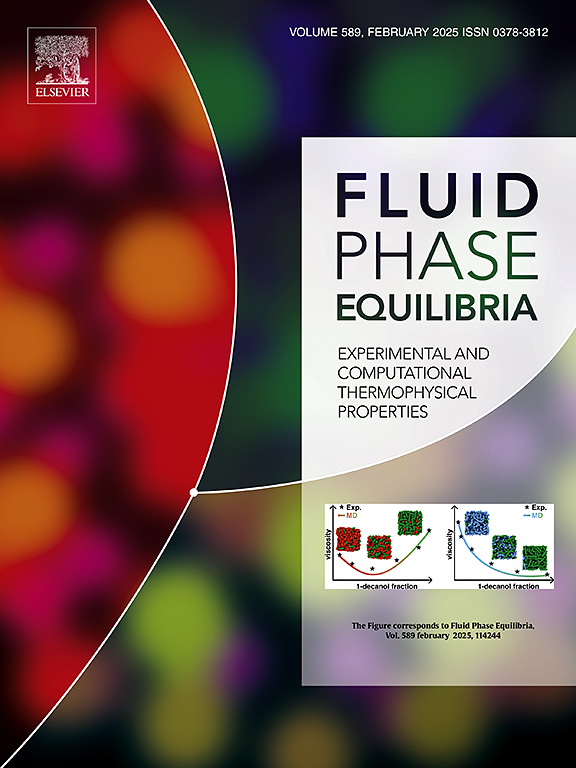Molecular dynamics simulations and experimental measurements of density and viscosity of phase change material based on stearic acid with graphene nanoplatelets
IF 2.8
3区 工程技术
Q3 CHEMISTRY, PHYSICAL
引用次数: 0
Abstract
Understanding the thermophysical properties of nano-enhanced phase change materials (NEPCMs) is crucial for developing thermal energy storage technologies. Thermal conductivity of NEPCMs is the most studied property, but investigations on density and viscosity are scarce. In this paper, the viscosity and density of pure stearic acid (SA) and stearic acid with 2 wt.%, 4 wt.%, and 6 wt.% graphene nanoplatelets (GNPs) of 6–8 nm thickness have been investigated from 343 K to 373 K at atmospheric pressure. The SA with GNP concentrations of 4 and 6 wt.% exhibits non-Newtonian behaviour, meaning that viscosity depends on shear rate. The viscosity and density for SA with 2 wt.% GNPs were measured, and the uncertainties for each property were calculated. Two empirical equations were used to correlate the viscosity and density data along the isotherms. Molecular dynamics simulations were performed to compute the density and viscosity and understand the molecular interaction of the GNP +SA system. A GNP nanoparticle (18-layer graphene nanoplate) embedded in 2123 SA molecules was simulated in a temperature range from 353 K to 378 K at a pressure of 0.1 MPa. The viscosity and density properties of a pure SA liquid and the GNP + SA system are compared with the experimental data. The orientation of the SA molecules for the pure SA and in the presence of GNP is investigated using the radial distribution function. The simulated density and viscosity exhibit the same trend as the experimental data. The simulations demonstrated that the GNP reorganises SA molecules on its surface, indicating a higher linear alignment of aliphatic chains of SA and, as a result, a greater local density of SA around the nanoplatelet.

基于硬脂酸和石墨烯纳米片的相变材料密度和粘度的分子动力学模拟和实验测量
了解纳米增强相变材料(NEPCMs)的热物理性质对于开发热储能技术至关重要。NEPCMs的热导率是研究最多的性质,但对密度和粘度的研究很少。本文研究了纯硬脂酸(SA)和硬脂酸与2 wt.%、4 wt.%和6 wt.%厚度为6 - 8 nm的石墨烯纳米片(GNPs)在343 K至373 K大气压下的粘度和密度。GNP浓度为4%和6%的SA表现出非牛顿行为,这意味着粘度取决于剪切速率。测量了GNPs为2 wt.%的SA的粘度和密度,并计算了每种性质的不确定度。两个经验方程被用来关联沿等温线的粘度和密度数据。通过分子动力学模拟计算了GNP +SA体系的密度和粘度,了解了体系的分子相互作用。在温度为353 ~ 378 K、压力为0.1 MPa的条件下,模拟了嵌入2123 SA分子的GNP纳米颗粒(18层石墨烯纳米板)。将纯SA液和GNP + SA体系的粘度和密度特性与实验数据进行了比较。用径向分布函数研究了纯SA和存在GNP时SA分子的取向。模拟的密度和粘度的变化趋势与实验数据一致。模拟结果表明,GNP在其表面重组了SA分子,表明SA的脂肪链具有更高的线性排列,因此,纳米血小板周围的SA局部密度更高。
本文章由计算机程序翻译,如有差异,请以英文原文为准。
求助全文
约1分钟内获得全文
求助全文
来源期刊

Fluid Phase Equilibria
工程技术-工程:化工
CiteScore
5.30
自引率
15.40%
发文量
223
审稿时长
53 days
期刊介绍:
Fluid Phase Equilibria publishes high-quality papers dealing with experimental, theoretical, and applied research related to equilibrium and transport properties of fluids, solids, and interfaces. Subjects of interest include physical/phase and chemical equilibria; equilibrium and nonequilibrium thermophysical properties; fundamental thermodynamic relations; and stability. The systems central to the journal include pure substances and mixtures of organic and inorganic materials, including polymers, biochemicals, and surfactants with sufficient characterization of composition and purity for the results to be reproduced. Alloys are of interest only when thermodynamic studies are included, purely material studies will not be considered. In all cases, authors are expected to provide physical or chemical interpretations of the results.
Experimental research can include measurements under all conditions of temperature, pressure, and composition, including critical and supercritical. Measurements are to be associated with systems and conditions of fundamental or applied interest, and may not be only a collection of routine data, such as physical property or solubility measurements at limited pressures and temperatures close to ambient, or surfactant studies focussed strictly on micellisation or micelle structure. Papers reporting common data must be accompanied by new physical insights and/or contemporary or new theory or techniques.
 求助内容:
求助内容: 应助结果提醒方式:
应助结果提醒方式:


